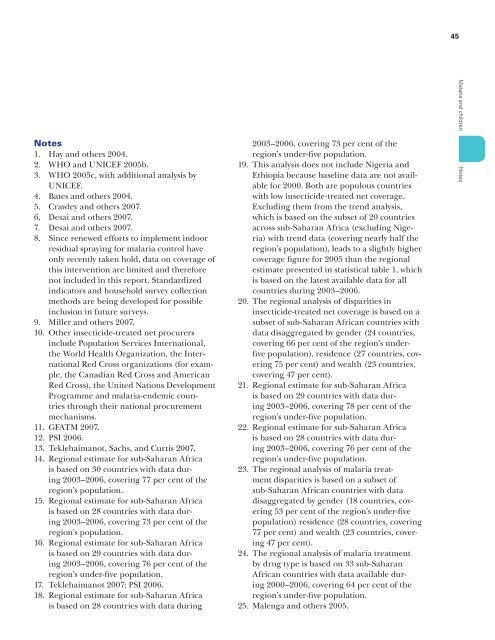Malaria and children: Progress in intervention coverage - Unicef
Malaria and children: Progress in intervention coverage - Unicef
Malaria and children: Progress in intervention coverage - Unicef
Create successful ePaper yourself
Turn your PDF publications into a flip-book with our unique Google optimized e-Paper software.
45<br />
Notes<br />
1. Hay <strong>and</strong> others 2004.<br />
2. WHO <strong>and</strong> UNICEF 2005b.<br />
3. WHO 2005c, with additional analysis by<br />
UNICEF.<br />
4. Bates <strong>and</strong> others 2004.<br />
5. Crawley <strong>and</strong> others 2007.<br />
6. Desai <strong>and</strong> others 2007.<br />
7. Desai <strong>and</strong> others 2007.<br />
8. S<strong>in</strong>ce renewed efforts to implement <strong>in</strong>door<br />
residual spray<strong>in</strong>g for malaria control have<br />
only recently taken hold, data on <strong>coverage</strong> of<br />
this <strong>in</strong>tervention are limited <strong>and</strong> therefore<br />
not <strong>in</strong>cluded <strong>in</strong> this report. St<strong>and</strong>ardized<br />
<strong>in</strong>dicators <strong>and</strong> household survey collection<br />
methods are be<strong>in</strong>g developed for possible<br />
<strong>in</strong>clusion <strong>in</strong> future surveys.<br />
9. Miller <strong>and</strong> others 2007.<br />
10. Other <strong>in</strong>secticide-treated net procurers<br />
<strong>in</strong>clude Population Services International,<br />
the World Health Organization, the International<br />
Red Cross organizations (for example,<br />
the Canadian Red Cross <strong>and</strong> American<br />
Red Cross), the United Nations Development<br />
Programme <strong>and</strong> malaria-endemic countries<br />
through their national procurement<br />
mechanisms.<br />
11. GFATM 2007.<br />
12. PSI 2006.<br />
13. Teklehaimanot, Sachs, <strong>and</strong> Curtis 2007.<br />
14. Regional estimate for sub- Saharan Africa<br />
is based on 30 countries with data dur<strong>in</strong>g<br />
2003–2006, cover<strong>in</strong>g 77 per cent of the<br />
region’s population.<br />
15. Regional estimate for sub- Saharan Africa<br />
is based on 28 countries with data dur<strong>in</strong>g<br />
2003–2006, cover<strong>in</strong>g 73 per cent of the<br />
region’s population.<br />
16. Regional estimate for sub- Saharan Africa<br />
is based on 29 countries with data dur<strong>in</strong>g<br />
2003–2006, cover<strong>in</strong>g 76 per cent of the<br />
region’s under-five population.<br />
17. Teklehaimanot 2007; PSI 2006.<br />
18. Regional estimate for sub- Saharan Africa<br />
is based on 28 countries with data dur<strong>in</strong>g<br />
2003–2006, cover<strong>in</strong>g 73 per cent of the<br />
region’s under-five population.<br />
19. This analysis does not <strong>in</strong>clude Nigeria <strong>and</strong><br />
Ethiopia because basel<strong>in</strong>e data are not available<br />
for 2000. Both are populous countries<br />
with low <strong>in</strong>secticide-treated net <strong>coverage</strong>.<br />
Exclud<strong>in</strong>g them from the trend analysis,<br />
which is based on the subset of 20 countries<br />
across sub- Saharan Africa (exclud<strong>in</strong>g Nigeria)<br />
with trend data (cover<strong>in</strong>g nearly half the<br />
region’s population), leads to a slightly higher<br />
<strong>coverage</strong> figure for 2005 than the regional<br />
estimate presented <strong>in</strong> statistical table 1, which<br />
is based on the latest available data for all<br />
countries dur<strong>in</strong>g 2003–2006.<br />
20. The regional analysis of disparities <strong>in</strong><br />
<strong>in</strong>secticide-treated net <strong>coverage</strong> is based on a<br />
subset of sub- Saharan African countries with<br />
data disaggregated by gender (24 countries,<br />
cover<strong>in</strong>g 66 per cent of the region’s underfive<br />
population), residence (27 countries, cover<strong>in</strong>g<br />
75 per cent) <strong>and</strong> wealth (23 countries,<br />
cover<strong>in</strong>g 47 per cent).<br />
21. Regional estimate for sub- Saharan Africa<br />
is based on 29 countries with data dur<strong>in</strong>g<br />
2003–2006, cover<strong>in</strong>g 78 per cent of the<br />
region’s under-five population.<br />
22. Regional estimate for sub- Saharan Africa<br />
is based on 28 countries with data dur<strong>in</strong>g<br />
2003–2006, cover<strong>in</strong>g 76 per cent of the<br />
region’s under-five population.<br />
23. The regional analysis of malaria treatment<br />
disparities is based on a subset of<br />
sub- Saharan African countries with data<br />
disaggregated by gender (18 countries, cover<strong>in</strong>g<br />
53 per cent of the region’s under-five<br />
population) residence (28 countries, cover<strong>in</strong>g<br />
77 per cent) <strong>and</strong> wealth (23 countries, cover<strong>in</strong>g<br />
47 per cent).<br />
24. The regional analysis of malaria treatment<br />
by drug type is based on 33 sub- Saharan<br />
African countries with data available dur<strong>in</strong>g<br />
2000–2006, cover<strong>in</strong>g 64 per cent of the<br />
region’s under-five population.<br />
25. Malenga <strong>and</strong> others 2005.<br />
<strong>Malaria</strong> <strong>and</strong> <strong>children</strong> Notes
















